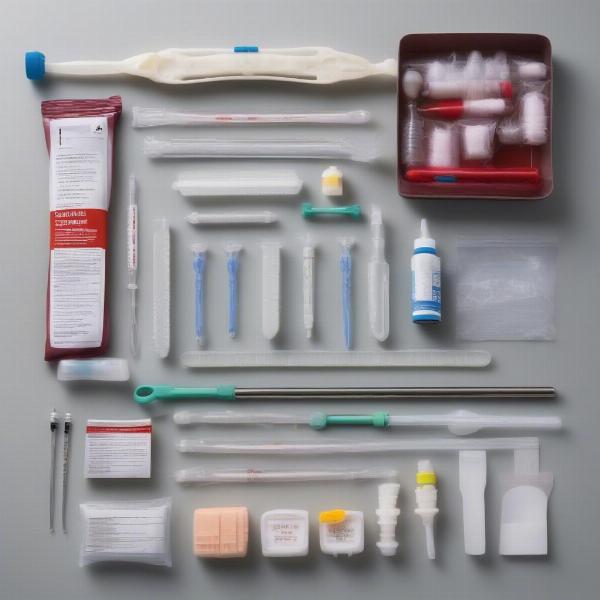Artificial dog insemination (AI) is becoming an increasingly popular method for breeding dogs, offering a range of benefits for both breeders and pet owners. Understanding what an artificial dog insemination kit entails, how to use it, and the factors that influence its success is crucial for anyone considering this breeding technique. This article will delve into the specifics of artificial dog insemination kits, providing valuable information for both novice and experienced dog breeders.
What’s in an Artificial Dog Insemination Kit?
An artificial dog insemination kit typically contains everything needed to collect and inseminate semen. While the exact contents can vary between manufacturers, most kits include:
- Sterile catheters: These are used to deposit the semen into the female dog’s reproductive tract. Different sizes are often included to accommodate various breeds.
- Syringes: Used for collecting and handling the semen. Specialized syringes may be included for precise semen measurement.
- Collection tubes: Sterile tubes for collecting and storing the semen prior to insemination. These often contain a nutrient-rich medium to preserve sperm viability.
- Lubricant: A sterile, water-based lubricant to aid in catheter insertion. Never use non-sterile or oil-based lubricants.
- Gloves: Sterile gloves to maintain hygiene throughout the process.
 Artificial Dog Insemination Kit Contents
Artificial Dog Insemination Kit Contents
Choosing the Right Artificial Dog Insemination Kit
Selecting the correct kit depends on several factors, including the breeder’s experience level and the specific needs of the dogs involved. Some kits are designed for fresh semen insemination, while others are geared towards chilled or frozen semen.
- Fresh Semen Kits: These are generally simpler and less expensive, as they don’t require specialized equipment for temperature control.
- Chilled/Frozen Semen Kits: These kits may include insulated containers, temperature monitoring devices, and specific extenders to maintain sperm viability during transport and storage.
How to Use an Artificial Dog Insemination Kit
While this article provides general guidance, it’s crucial to consult with a veterinarian or experienced reproductive specialist for hands-on training before attempting AI. The process generally involves the following steps:
- Semen Collection: The male dog’s semen is collected using a specialized technique.
- Semen Evaluation: The semen is assessed for quality, including motility and concentration.
- Catheter Insertion: The appropriate catheter is carefully inserted into the female dog’s vagina.
- Insemination: The semen is slowly deposited through the catheter into the uterus.
Factors Influencing Success
The success rate of artificial insemination in dogs depends on several factors:
- Timing: Insemination should be timed to coincide with the female dog’s ovulation.
- Semen Quality: High-quality semen with good motility and concentration is essential.
- Technique: Proper handling and insemination techniques are crucial.
- Female Dog’s Health: A healthy reproductive tract in the female dog is important for successful implantation.
Conclusion
Artificial dog insemination kits offer a valuable tool for breeders, allowing for greater control over breeding practices and access to genetically diverse sires. artificial dog insemination kit However, proper training and understanding of the process are essential for achieving successful results. Consulting with a veterinarian experienced in canine reproduction is highly recommended. canine artificial insemination kit dogs
FAQ
- What is the average cost of an artificial dog insemination kit? The cost can vary depending on the type of kit and its components, typically ranging from $50 to $200.
- Where can I purchase an artificial dog insemination kit? Kits can be purchased from veterinary supply stores or online retailers specializing in animal breeding supplies. artificial insemination dog kits
- Is artificial insemination painful for dogs? When performed correctly by a trained professional, the procedure is generally not painful. dog insemination kit
- What are the advantages of using artificial insemination in dogs? Advantages include access to genetically superior sires, reduced risk of disease transmission, and the ability to breed dogs geographically separated.
- What is the success rate of artificial insemination in dogs? Success rates can vary, but with proper timing and technique, they can be comparable to natural breeding. artificial insemination for dogs kit
ILM Dog is a leading international online resource dedicated to providing expert advice and information on all aspects of dog care and breeding. We offer comprehensive resources on dog breeds, health, training, nutrition, grooming, and much more. For expert guidance on dog breeding and artificial insemination, contact our team of experts at [email protected] or call us at +44 20-3965-8624. ILM Dog is your trusted partner in providing the best possible care for your canine companion.